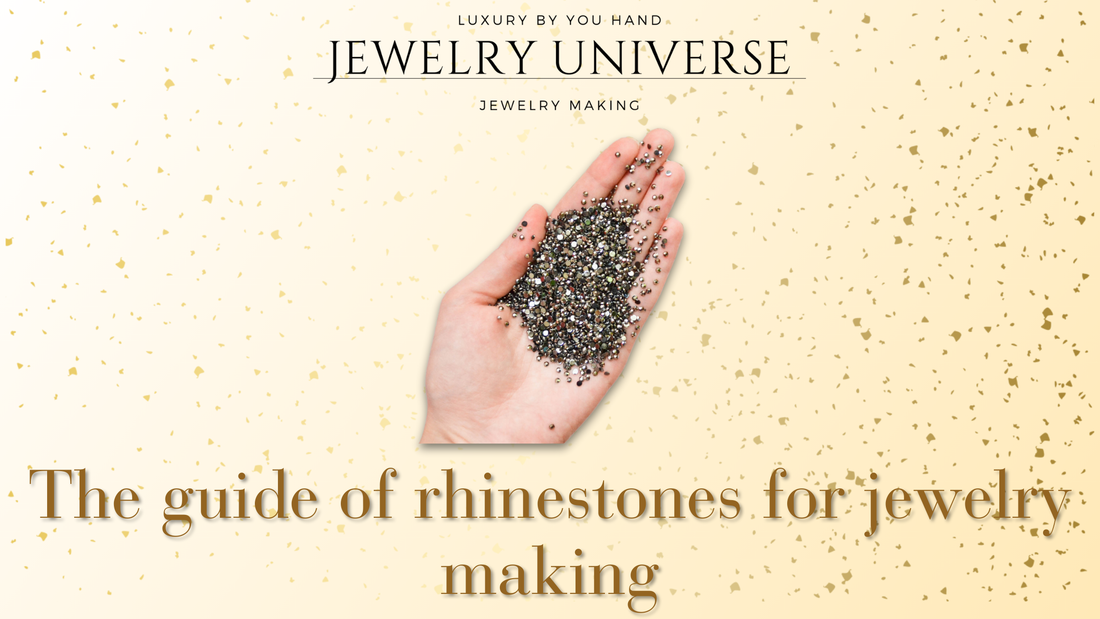
The guide of rhinestones for jewelry making
Share
Rhinestones are an essential component for creating sparkling, eye-catching jewelry. Whether you're a beginner or a seasoned jewelry designer, working with rhinestones for jewelry making opens the door to endless creative possibilities. In this guide, we will explore how to select, use, and craft unique rhinestone jewelry while giving you expert tips, step-by-step instructions, and ideas to inspire your next masterpiece.
What are rhinestones and why use them?
Understanding rhinestones
- Rhinestones are imitation gemstones made of glass, acrylic, or crystal designed to mimic the sparkle of diamonds and other precious stones.
- They come in a variety of shapes, sizes, and colors, offering flexibility for diverse jewelry styles.
Benefits of using rhinestones for jewelry
- Affordable and accessible: Rhinestones allow you to achieve a luxurious look at a fraction of the cost of real gems.
- Versatile: They can be used in earrings, bracelets, necklaces, and even clothing accessories.
- Sparkling finish: Rhinestones add an instant touch of glamour to any jewelry piece.
Types of rhinestones for jewelry making
Based on materials
- Glass rhinestones: Offer excellent clarity and shine but are slightly heavier.
- Acrylic rhinestones: Lightweight and ideal for larger pieces or costume jewelry.
- Crystal rhinestones: High-quality rhinestones like Swarovski crystals that provide unmatched sparkle.
Shapes and cuts
- Round rhinestones: The most common choice for classic designs.
- Flatback rhinestones: Perfect for gluing onto surfaces.
- Pointed-back rhinestones: Used for settings like bezels or prongs.
- Fancy shapes: Stars, hearts, and teardrops for creative designs.
Tools and materials needed for working with rhinestones
Essential tools
- Jewelry pliers: Round-nose, flat-nose, and cutters for assembling pieces.
- Tweezers or rhinestone pickers: To handle small rhinestones with precision.
- Jewelry adhesive: E6000, gem-tack glue, or epoxy for a strong bond.
- Bezel settings: Frames or settings to hold rhinestones in place.
Complementary materials
- Chains and wires: For creating necklaces, bracelets, or earrings.
- Clasps and hooks: To assemble your jewelry pieces.
- Beads and pearls: Combine with rhinestones for a layered look.
Techniques for setting rhinestones
Gluing rhinestones
- Prepare the surface: Ensure it is clean and dry.
- Apply a small amount of glue: Use a toothpick or precision tip applicator.
- Place the rhinestone: Use tweezers or a rhinestone picker for accuracy.
- Allow to dry: Let the glue cure fully for a secure hold.
Pro Tip: Use flatback rhinestones for this method as they sit flush on surfaces.
Setting rhinestones with prongs
- Choose a pointed-back rhinestone and a prong setting.
- Place the rhinestone into the setting.
- Carefully bend the prongs over the edges to secure the stone.
Step-by-step: Creating rhinestone jewelry
Designing a rhinestone necklace
- Choose your centerpiece rhinestone: Opt for a larger stone in a teardrop or round shape.
- Plan the layout: Arrange smaller rhinestones around the centerpiece to create balance.
- Assemble the chain: Use pliers to attach a chain and clasp.
- Glue or set the rhinestones: Carefully position each stone in its designated spot.
Making rhinestone stud earrings
- Select two rhinestones of the same size and shape.
- Choose earring posts with a flat surface.
- Apply a drop of adhesive and press the rhinestone onto the post.
- Let the glue dry completely before wearing.
Creative ideas for rhinestone jewelry
Classic rhinestone pieces
- Rhinestone chokers: A timeless accessory that pairs perfectly with formal wear.
- Layered rhinestone bracelets: Stack bracelets with different colors of rhinestones for a glamorous look.
Modern rhinestone designs
- Minimalist earrings: Small, single rhinestones on stud settings for everyday elegance.
- Geometric pendants: Create modern shapes with rhinestones like triangles or hexagons.
Statement pieces
- Rhinestone bib necklaces: Use multiple stones to create bold, eye-catching designs.
- Crystal-encrusted cuffs: Cover a wide bracelet band with rhinestones for a dazzling effect.
Tips for working with rhinestones
Achieving a professional finish
- Use minimal glue: Excess adhesive can ruin the sparkle and neatness of your design.
- Test placement first: Arrange your rhinestones on the design without glue to perfect the layout.
Choosing the right rhinestones
- For delicate jewelry: Opt for smaller stones and lighter materials like acrylic.
- For high-end pieces: Invest in crystal rhinestones for their superior shine.
How to care for rhinestone jewelry
Preventing damage
- Avoid water and chemicals: Remove rhinestone jewelry before bathing or swimming.
- Store carefully: Keep pieces in a jewelry organizer to avoid scratches or dislodging stones.
Cleaning rhinestones
- Use a soft cloth to gently wipe dirt or dust.
- For deeper cleaning, dip the jewelry in a solution of mild soap and water.
- Avoid using harsh chemicals or brushes, as they may damage the adhesive.
Where to buy rhinestones for jewelry making
Online stores
- Amazon: A wide variety of rhinestones in bulk at affordable prices.
- Etsy: High-quality, unique rhinestones for custom designs.
Craft supply stores
- Michaels, Hobby Lobby, or Joann’s offer rhinestones in multiple materials, shapes, and sizes.
Specialized suppliers
- Swarovski retailers for premium crystal rhinestones.
- Local bead shops for smaller quantities and unique finds.
Rhinestones for jewelry making are a versatile and budget-friendly choice for crafting sparkling accessories. Whether you’re creating elegant necklaces, minimalist earrings, or bold statement pieces, rhinestones offer endless opportunities to express your creativity.
